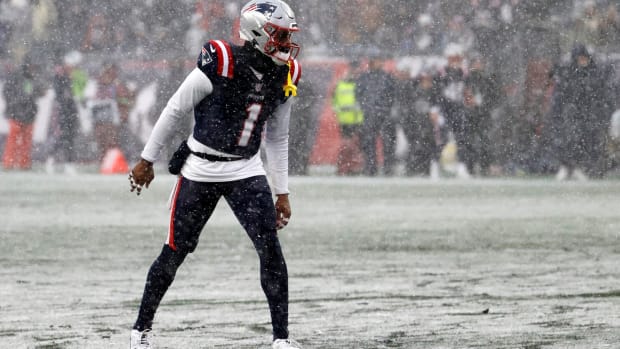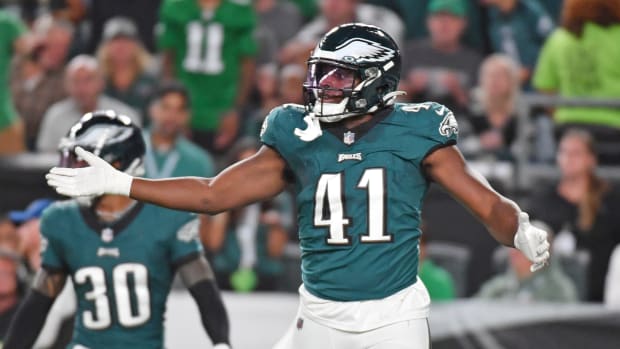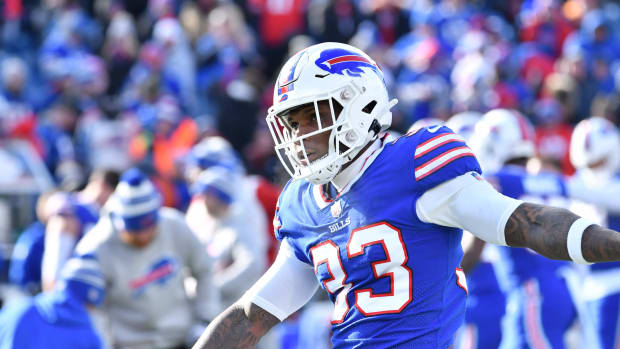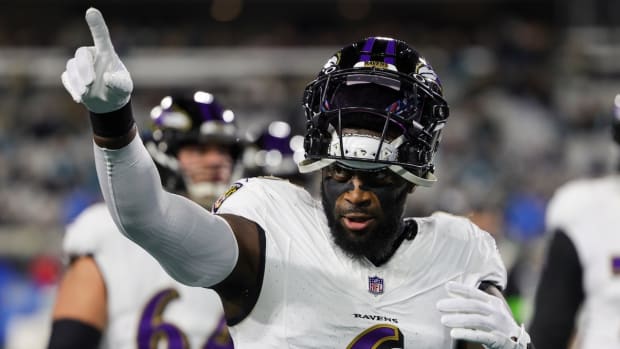Breaking Down the NFL's Elite Eight
Rob Carr/Getty Images
Baltimore Ravens at New England Patriots
Patriots offense vs. Ravens defense
It’s as if Baltimore’s makeshift secondary was sprinkled with fairy dust just before the wild-card game at Pittsburgh. Nobody could have guessed that guys like Rashaan Melvin and Anthony Levine would outplay a receiving corps of Antonio Brown, Martavis Bryant and Markus Wheaton. It helped that Baltimore’s four-man pass rush erupted in the second half.
Patriots vs. Ravens
Steve Smith’s plan and personal ethosJustin Forsett emerged out of the shadowsRevis Unplugged: On joining forces with Belichick and Brady, Rex Ryan, and bump-and-run vs. the NFL's eliteBrady through the eyes of former teammates
The no-name corners aren’t the key this week; the Patriots’ passing attack is focused largely between the field numbers, where linebackers and safeties are primary defenders. It’s vital that the Ravens disrupt Rob Gronkowski’s timing off the line of scrimmage. He’ll burn them, especially in the seams off play-action, if given a clean release. Courtney Upshaw will be a critical component here on base downs. He can exert physicality when Gronk is in his usual tight end spot or aligned in the slot. Upshaw, however (like almost any defender) will need help—something the Ravens can most easily distribute out of zone coverage. They were great in this capacity against Pittsburgh.
If the Ravens go man-to-man, it will be safety Will Hill drawing the Gronkowski matchup. The talented-but-oft-troubled ex-Giant has been a Godsend for this secondary. And he has won several wars in man coverage against tight ends this season, including Jimmy Graham and Antonio Gates.
Ravens offense vs. Patriots defense
It’s a myth that running the ball is mandatory for setting up play-action, but as Baltimore’s wild-card performance showed, a good running game propagates stronger play-action. The Ravens did not have impressive final rushing numbers—only 49 yards on 25 runs – but they were effective just enough on zone-stretch concepts in the first half (Justin Forsett 41 yards on six carries) to set up their moving-pocket play-action game in the second half. That’s precisely how Gary Kubiak’s system is designed to work.
They’ll have to be even better on the ground this week. The Patriots, for one, have bulk along their defensive line, starting with Vince Wilfork, who should line up as a nose-shade against nimble-but-undersized center Jeremy Zuttah. If Zuttah can’t reach around and seal the interior defensive lineman, the stretch concepts don’t work.
Secondly, being a man-based defense, the Patriots are less susceptible to play-action than are the zone-based Steelers. (In man coverage a lot of the defenders are looking at their receivers and don’t see—and therefore don’t react to—the play fakes.) But a man coverage defense is vulnerable against crossing patterns and misdirection routes, which the Ravens often employ out of their fake zone-stretch runs.
Still, don’t be surprised if Joe Flacco has more straight dropback attempts in this one. Other ways to beat man-to-man is to stack receivers, put them in motion and run intersecting routes off the line of scrimmage—all tactics Kubiak will use with Steve Smith and Torrey Smith going against Darrelle Revis and Brandon Browner.
Ravens-Patriots | Panthers-Seahawks | Cowboys-Packers | Colts-Broncos
For film study tweets throughout the week, follow @Andy_Benoit
Grant Halverson/Getty Images
Carolina Panthers at Seattle Seahawks
Seahawks offense vs. Panthers defense
When these teams met in Week 8, the Panthers secondary stymied the Seahawks receivers. The linebackers and D-linemen bogged down in the red zone (and were aided by a few Seattle mistakes). And, most important, the Panthers controlled Russell Wilson’s running. Until the final series, that is, when the Seahawks went on a four-minute, 80-yard drive for the game-winning touchdown (tight end Luke Willson down the seam from a closed formation, which out-leveraged Tre Boston’s man-free coverage). On that drive, Wilson had a scramble of 14 yards (versus Cover 2, pocket collapsing) and a seven-yard read-option on second-and-five.
2014 in Review
The 2014 MMQB awardsThe NFL season through the eyes of SI photographersHow all 32 teams finished compared to preseason predictionsThe NFL’s best and worst business decisions of 2014
Since that game, the Seahawks offense has become even more centered around Wilson’s mobility—not just his running but also his movement skills that recalibrate passing angles and push the action into sandlot mode. The Panthers, a strict zone-based defense, won’t be able to sustain coverage spacing and assignments against this. They’d be wise to attack and send extra rushers at Wilson, trusting that their revamped, more athletic secondary can win one-on-one battles and that Luke Kuechly and Thomas Davis, who play with better speed and angles than any linebacking tandem in the league, can chase down Wilson when needed.
Panthers offense vs. Seahawks defense
Carolina’s read-option rushing attack has caught fire during a five-game winning streak, but none of the defenses the Panthers faced (New Orleans, Tampa Bay, Cleveland, Atlanta and Arizona) have as much speed in the base package as Seattle does. It’s risky leaving defensive end Michael Bennett unblocked and trusting pulling guards and tackles to offset this by reaching athletic linebackers Bobby Wagner and K.J. Wright. Seattle’s defensive backs are also very stout tacklers (or, in the case of safeties Earl Thomas and especially Kam Chancellor, fierce hitters).
Let’s say the Panthers need Cam Newton to make six or seven big plays in obvious passing situations. His ability to do that depends on his mechanics. He wasn’t consistent here last week; it’s unlikely he will be this week in a tough road environment against a swarming D that compels quarterbacks to play fast. The passing game will also hinge on Kelvin Benjamin’s and Greg Olsen’s ability to make contested catches against physical defensive backs.
Carolina’s best course: take downfield shots on first down. The Seahawks will be in their staple Cover-3 look. A great tactic against this is a route combination known as “four verticals.” In Carolina’s case, that means two receivers and two dual line of scrimmage tight ends running straight downfield (with the tight ends gradually drifting apart). Last week at Arizona this equation twice got receivers uncovered 20 yards downfield; Newton, unfortunately, missed a throw and a read. Offensive coordinator Mike Shula should dial up similar concepts Saturday night.
Ravens-Patriots | Panthers-Seahawks | Cowboys-Packers | Colts-Broncos
For film study tweets throughout the week, follow @Andy_Benoit
Ronald Martinez/Getty Images
Dallas Cowboys at Green Bay Packers
Packers offense vs. Cowboys defense
It’s astonishing that Dallas’s no-name, overachieving defense has yet to truly be exposed. It helps that the offense keeps them off the field. Still, at this point, doubters (like yours truly) must tip their cap to coordinator Rod Marinelli and his men.
This isn’t to say that the Cowboys won’t have trouble against the Packers. Mike McCarthy loves to align his receivers outside the numbers and force defenders to cover in space. These wide formations also set up Green Bay’s patented quick slant and smoke screen passes. Tackling becomes critical for cornerbacks. For most of the season the Dallas corners have stayed in the same look: Brandon Carr on the left, nickel man Sterling Moore on the right and Orlando Scandrick in the slot. But against Detroit, the Cowboys matched up to personnel (based on body types and playing styles), putting Carr (with plenty of safety help) on Calvin Johnson and having Scandrick take Golden Tate.
The MMQB Podcast
Insights from Andy Benoit on this weekend's playoff games.
It’ll be interesting to see if Marinelli does the same again this week. Carr and the safeties would take Jordy Nelson, making the deciding matchup Scandrick versus Randall Cobb. How this goes could depend on how quickly Dallas’s improving, high-energy (but still not frightening) pass rush forces Aaron Rodgers to throw.
Cowboys offense vs. Packers defense
As we talked about last week, the Cowboys needed to run the ball out of three-receiver sets and exploit the Lions’ lighter nickel box. In the wild-card game, DeMarco Murray had 70 yards on 14 carries out of three-wide and just five yards on five carries out of base personnel.
Granted, Detroit’s base run defense is much stouter than Green Bay’s. This week Murray and that star-studded O-line should get consistent movement against a front seven that has improved along the defensive line but has been searching for answers all season at inside linebacker. The Packers seem to have found the right answer in recent weeks, with Clay Matthews working alongside A.J. Hawk in the traditional 3-4 and Matthews working with the more athletic Sam Barrington in the “big nickel” base.
Going three-wide would put the Packers in that “big nickel.” Offensive coordinator Scott Linehan could then aid his run plays with route combinations that have receivers moving away from the ball, dragging their defender out of the picture (in football parlance this is known as an “easy release”). That would help make the inexperienced Barrington the force defender against more runs.
Ravens-Patriots | Panthers-Seahawks | Cowboys-Packers | Colts-Broncos
For film study tweets throughout the week, follow @Andy_Benoit
Doug Pensinger/Getty Images
Indianapolis Colts at Denver Broncos
Broncos offense vs. Colts defense
In the teams’ Week 1 matchup, Julius Thomas scored three touchdowns in the second quarter, including one against linebacker D’Qwell Jackson out of a base two-tight end closed formation (the Colts played base 3-4) and one as an X-iso receiver opposite trips, which drew a matchup against LaRon Landry in space (advantage Broncos—always).
Football, 24/7
Keep up with the latest from Peter King and The MMQB team.
If Thomas’s bum ankle is fully healed, don’t be surprised if offensive coordinator Adam Gase goes back to the pass-first approach that he and Peyton Manning used over the first 10 games of the season. There are concerns about the offensive line’s ability to sustain pass protection out of this approach, but those concerns aren’t applicable against a Colts team that has no speed rushers. Any pressure Indy generates will be via blitz—and blitzing Manning is always precarious.
The Colts, if they choose, can at least be aggressive in their blitzes given their solidity in man coverage with outside corners Vontae Davis and Greg Toler. The Broncos have a lot of formational diversity in their playbook; look for Demaryius Thomas and Emmanuel Sanders to line up inside in order to draw favorable matchups against Indy’s ancillary pass defenders.
Colts offense vs. Broncos defense
It’s considered bad form in football to admit that you’re incapable of running the ball; old-schoolers interpret this as unaggressive and impure. But the Colts have been so inept on the ground that even the defensive-minded Chuck Pagano and somewhat old-school coordinator Pep Hamilton have had to find euphemistic ways to politely tell the media “we can’t run.” Hamilton, through his play selection, has unequivocally told everyone the Colts can’t run. He went to the air on 20 of the first 25 snaps against the Bengals last week, even with Dan Herron actually running well on the opening series.
Herron seems to have emerged as the feature back, with undrafted rookie Tipton Zurlon serving as the No. 2, mercifully relegating Trent Richardson to bench-warming duties (something that, frankly, should have happened long ago). Herron was proficient as a check-down receiver in that wild-card win, and he’ll have to be again this Sunday. With no running game to worry about, the Broncos will keep two safeties back in man coverage. That’s the most difficult defensive look to throw downfield against, especially when it’s the Broncos, given their talent at cornerback.
Ravens-Patriots | Panthers-Seahawks | Cowboys-Packers | Colts-Broncos
For film study tweets throughout the week, follow @Andy_Benoit
Follow The MMQB on Facebook, Twitter and Instagram.
[widget widget_name="SI Newsletter Widget”]





















































